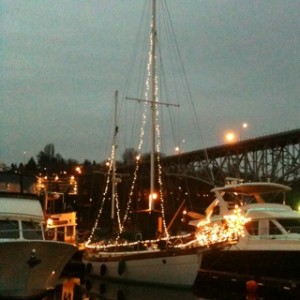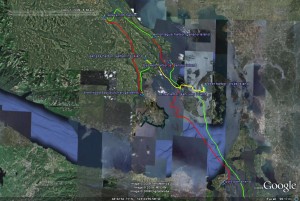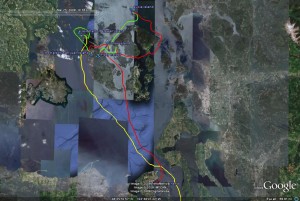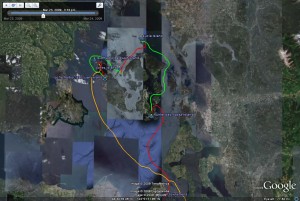To make it easier to inspect and work on the main masthead, I installed two folding steps about 4 feet below the top of the mast. I’m building a 3:1 system from Harken hexaratchet blocks to be able to pull myself up. Once up there I will be able to stand on the steps, tie off, and work at chest level to inspect, change anchor bulbs, VHF antenna, windvane, etc. Trying to do this from a bosun chair is difficult because you’re working above your head and can’t see the very top. First project will be to change the anchor bulb to LED.
All posts by Captain Jim
Installing AIS Transceiver
An Automatic Identification System (AIS) is an electronic device that allows you to see other vessels (who also have AIS) on a chartplotter. Ships and ferries are required to have AIS, and it’s becoming more common for smaller vessels. AIS for smaller vessels comes in two types–receive only that allows you to see others, and transmit/receive that allows you to see other and for them to see you. AIS uses a combination of GPS and VHF to transmit and receive information. A chartplotter will display a triangular mark for each vessel it is receiving a signal from. Selecting a mark then brings up a screen showing information such as vessel name, home port, vessel speed and for ships, it shows what cargo it’s carrying.
The main reasons for having AIS aboard is for safety. It’s kinda like an modern form of radar since it allows you to see other vessels electronically. Radar of course also allows you to see land and rain squalls. We’ve been in thick fog where we relied on our radar to locate ships that were blasting foghorns. Having a more accurate system at the helm will add redundancy and safety. Also, on ocean passages the AIS can be used as a warning to sound an alarm when a vessel broadcasting AIS gets within a certain distance.
I decided on a class B AIS from West Marine that transmits and receives information. It has a “silent” button on the case that allows you to silence the transmit function. The installation involved lots of wiring–coaxial wire to a VHF antenna (fortunately my boat had a spare VHF antenna installed on the main mast with the wire coiled and labeled in the bilge–shows somebody was thinking ahead!), a cable to a GPS antenna (not sure where I will mount this antenna yet), PWR/GND wires to the electrical panel, and 2 strands on NMEA cable to the chartplotter. I decided to tie the AIS into the Garmin chartplotter at the helm. When I installed the cable for this chartplotter, I ran the data cables near the electrical panel so they will be easy to get to.
New Dickinson Stove
Finished installing the new Dickinson 3-burner Mediterranean propane stove. This replaced an older HilleRange model that now sits at Second Wave Marine, a consignment boating store. The new Dickinson is 100% stainless steel, has dual 7000 BTU burners and 1-11000 BTU stove burner. The oven is larger than our old one and has a7000 BTU burner plus a 4500 BTU broiler. Other features: electronic ignition (no more matches!), gimbaled mount kit, safety flame-out protection, removable cutting-board on top, and pot-holders. The hardest part of the installation was fitting it through the companionway since it was both heavy and bulky. There was about 1″ of clearance!
For photos, see “Latest Pics from my iPhone”
Desolation Sound
Seattle Boat Show
Christmas Cruise 2010
Fleming Wind Vane
A Fleming mechanical self-steering wind vane came with Apropos and has been kept in my garage the past 4 years. It’s an older model built in the 1980’s, but appears to be in great shape. The system is a bulky stainless steel mechanical marvel that weighs a ton. It attaches to the stern with 4 struts and its purpose is to steer the boat in a desired direction using only the wind. It has a wind vane, a small rudder attached to a pendulum, and a drum that connects to the wheel. Once the boat is heading in a desired direction with respect to the wind, the pendulum will make adjustments to the wheel whenever the heading (with respect to the wind) changes. A linkage (two 6 mil nylon lines) goes from the pendulum to a wheel adapter, which is a drum fastened to the wheel. The drum is wrapped 3-4 times with 8 mil nylon rope that has eyes on both ends. These systems are very helpful for offshore cruising so you don’t have to sit behind the wheel hand steering all the time. I recently took the system apart and freed the toothed adjusting disc that had seized from years of sitting around. It took lots of WD-40 solvent and some time before it finally turned easily. The only piece I believe is missing is the drum that connects onto the wheel. Tonight I finally got thru to Fleming (based in Australia) and ordered a new stainless steel wheel adapter and a storm vane (a smaller wind vane used when the wind is really blowing). Both will be shipped to Sydney since we’re going there in a few weeks. They were $643 AUS including shipping. I plan on hooking it up to Apropos this summer and trying it out during our trip to the Gulf Islands in August.



